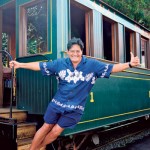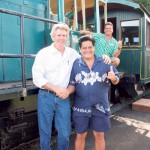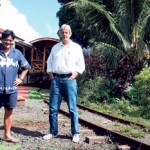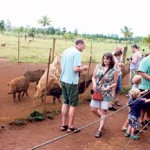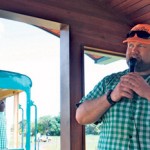Catching The Train
If you build it, people will come … to ride a homegrown train that bridges the plantation era and what Kaua’i farmers are growing today
Pepe Trask had never before built a train track – or much of anything else – but his hard work and dedication gave life to Fred Atkins’ dream of running a train that teaches visitors and locals alike about the past and present of Kaua’i agriculture
No one said building a railroad was easy, but that seems to be what lured Pepe Trask into the endeavor. The general manager of Kaua’i Plantation Railway at Kilohana helped build the 2.5-mile line with his own two hands, from tamping the earth for 450,000 pounds of rail to setting 6,500 wood ties and hammering 27,000 spikes.
And he still actively maintains it.
- Pepe Trask had never before built a train track – or much of anything else – but his hard work and dedication gave life to Fred Atkins’ dream of running a train that teaches visitors and locals alike about the past and present of Kaua’i agriculture
- (from left) Owner Fred Atkins, Pepe Trask and train engineer Bruce Labok
- Pepe Trask laid the tracks for the train that Fred Atkins dreamed of running
“If there’s a repair that needs to be made, it’s not like I can go to the Yellow Pages and look under ‘railroad,'” he says, taking a break from putting a replacement tie in place. “I’ve got to get out here and do it.”
In 2004, Kilohana Plantation leased land adjacent to its plantation estate site.
“When Lihu’e Land Company started leasing some of the sugar fields, Kilohana felt it was necessary to acquire the property adjacent to ours in order to make sure it would not affect our property and especially Gaylord’s restaurant,” owner Fred Atkins explains. “We first decided to create an agricultural park to showcase what our island farmers were doing on the acreage that was once sugar cane. The train concept was part of the evolution of being able to showcase what our local farmers are doing with the 67 acres we leased. It was a major gamble and undertaking.”
Offering a scenic ride with a farm-to-table concept, the train chugs through fruit tree orchards and herds of wild pigs, sheep and goats.
Trask says he became intrigued by the project in 2005, when he first heard that Atkins, a paddling buddy, was building the train.
“So I called him and said, ‘You’re looking for someone to build it?’ We had lunch and discussed his plans to build an 85-ton train at Kilohana, and at that time nothing existed on the ground – no track, nothing.”
Trask says when he offered to build it for Atkins, Atkins’ response was: “Do you know how to work?”
“I was flabbergasted,” Trask says, but excited by the challenge. “The only thing I knew about a hammer was it was in my tool box, along with the screwdriver, whatever that was.”
The Kilohana Train runs seven days a week: 10 and 11 a.m., noon, 1 and 2 p.m. Cost is $18 for adults, $14 for children 3-12.
The Train-Nature Walk-Lunch-Orchard Adventure runs seven days a week. Check-in is at 9:30 a.m., returning at 1:40 p.m. Cost is $75 for adults, $60 for children ages 3-12.
The Luau Express Train Tour and Luau Kalamaku features an open bar” and imu ceremony with roasted pig, live Hawaiian music and hula performances and fire dancers Tuesdays and Fridays at 5 p.m. Luau-only price: Adults $99, Teens $69, Children $49, free for children under 3. Train Tickets: Adults, $18, Children 3-12 years, $14.
- Visitors check out a variety of farm animals
- Engineer Bruce Labok talks to train riders about the history of Kaua‘i agriculture
- A view from the train
Kama’aina: The rates to ride the train for locals is $12 for adults and $10 for keiki; $10 for adults and $7 for keiki Sundays. Local schools and clubs receive a discounted group rate of $5 for adults and $3 for keiki.
They enlisted the help of railroad consultant Brook Rother and project architect Boone Morrison, and cleared “unruly” sugar cane fields and plotted the destination for railroad tracks. The project initially began with Trask and four boys, whom he says stopped showing up about a month into the project. That’s around the time Atkins’ son Nick, 18, joined Trask on the job.
“I remember Fred (Atkins) drove up one day and got out of the car with a young boy, and my immediate reaction was, ‘I gotta baby-sit this skinny haole kid.’ But lo and behold, both Nick and Fred are the hardest-working men I’ve ever met – industrious and full of aloha.”
In 10 months, they finished it. During that time, Trask says he researched America’s railroad system, and fell in love with its history.
“This idea of the Irish vets bringing the tracks from the East and the Chinese coming from the West, and meeting on the plains of Utah, inspired me.”
At the end of the project he had a profound appreciation for what dedication, vision and hard work really is.
“And, of course, once I built it, I then had to fill it,” he says.
Drawing in people seems natural to Trask, who brings sincere and positive energy to the historical presentation he gives to passengers. Perhaps that’s why folks line up to climb aboard the vintage, custom cars and set off along the railroad line pulled by a 1948 General Electric electric-diesel locomotive. On board, Trask shares anecdotes that hearken back to a different time: Hawaii’s golden era, when sugar was king.
“The Civil War was the reason the sugar industry boomed in Hawaii,” Trask explains to his audience. “The Union was no longer getting its sugar from the South.”
Trask says it fulfills him to have people enriched by historical Kaua’i: “Our guides and conductors are Hawaiian, and I teach them and demand of them to be truthful, accurate and share their aloha.”
In addition to helping manage Kilohana, Trask handles marketing for its train luau, Koloa Rum Company and Gaylord’s Restaurant.
“Pepe plays an integral part in the marketing of our product, the merchandising of our Depot Store and making sure the track is safe,” Atkins says, noting he’s not just working to bring business from the cruise ships, but local people.
“The reason I want to have kama’aina pricing is that there are two worlds on Kaua’i,” Trask says. “The visitor world and our real world. And the local people cannot do the activities that the visitors have, and they don’t do it. They don’t fly in helicopters, but they can come to Kilohana, and love it.”
Perhaps advocating for local people is ingrained in Trask, whose roots are steeped in both Kaua’i and in law. A third-generation trial lawyer (his son Mauna Kea is a fourth-generation attorney), his grandfather was from the Ko’olau district in Moloa’a, and his father was born and raised on Kaua’i. Though Trask was born and raised on Oahu, he “fell out of love with it” as the island became too crowded. He moved to Kaua’i in 1983 and practiced law until 1999. That same year he became an entrepreneur, and started a company called Aloha Canoes and Kayaks.
“We did tours up the Hule’ia River and Kipu Ranch,” he recalls. “I enjoyed it immensely because I was in the ocean and sharing all my aloha.”
It was a natural fit for the avid canoe paddler, who came to the sport at age 48 but managed to cross Molokai channel 16 times. Passionate about paddling, he’s also paddled the entire Hawaiian archipelago to the Laysan atolls.
Atkins says it’s that same kind of passion and aloha Trask has for the train that resonates with others.
“He is so positive, full of energy and has great ideas,” Atkins says. “He loves his work, and the people who visit our train operation sense that.”

